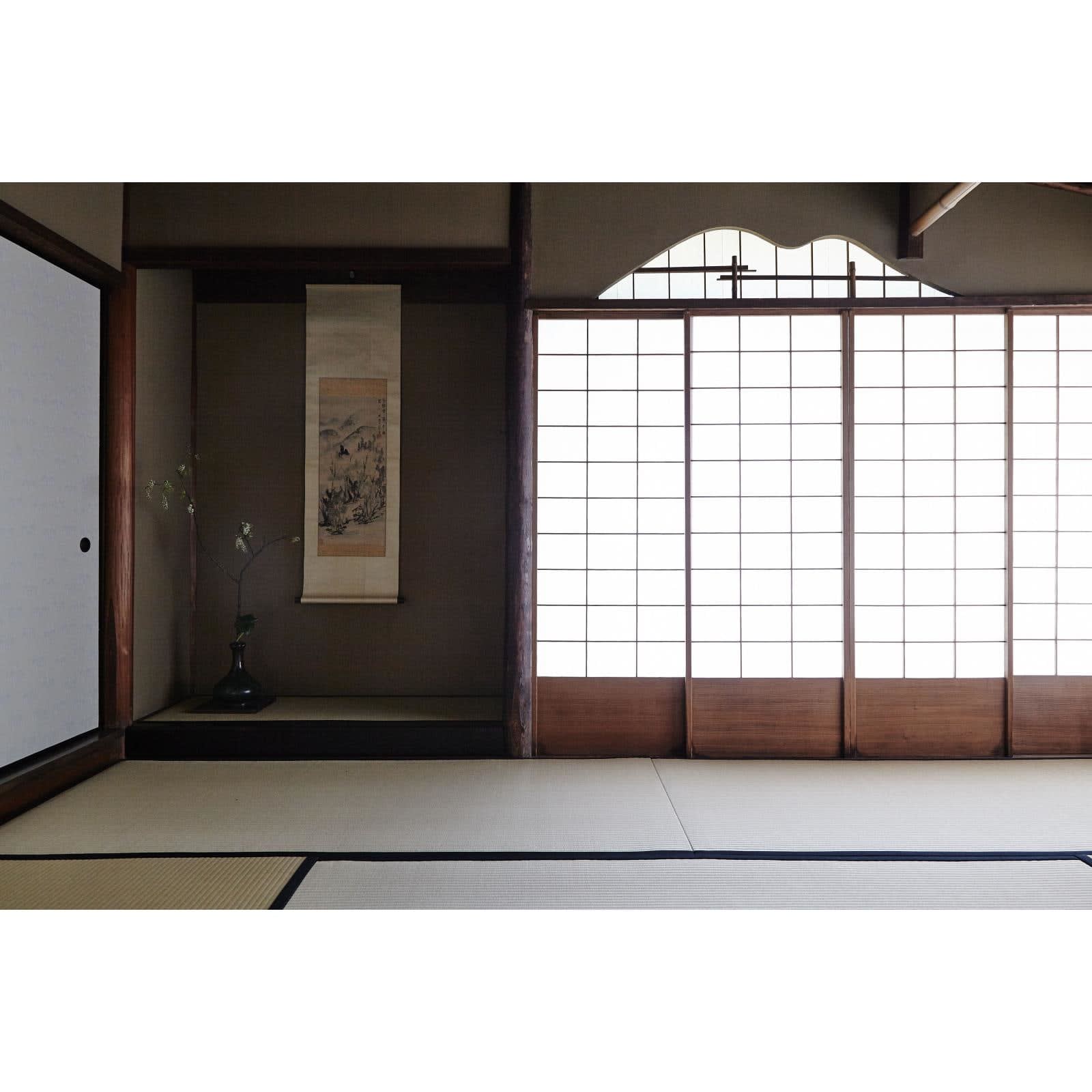Ike no Taiga (1723–1776)
Visiting a Friend in His Riverside Hermitage in Spring
Color on paper, hanging scroll
Inscription by the artist
Seals: Ike Kin no in; Kobin; Kofu Seigetsu
65.5 x 29.2 cm
141 x 41.5 cm (overall)
Inscription by the artist
Seals: Ike Kin no in; Kobin; Kofu Seigetsu
65.5 x 29.2 cm
141 x 41.5 cm (overall)
Further images
Provenance
Collection of Ueda Tan’anLiterature
The Works of Ike-no Taiga. Tokyo: Chuo-koron Bijutsu Shuppan, 1960.
“Flowers interspersed through overlapping trees, light clouds in the mountains here and there.” Ike no Taiga likely both composed and inscribed this verse. The light purple flowers dotted across a lush forest in the foreground correspond to the first line, while the unpainted clouds wafting between the mountains in the background concurs with the second. Taiga’s signature here suggests that the artist painted this work some time around the ages of twenty-two to twenty-five. The foreground scenery shares characteristics with Fording a Stream under Willow Trees, which Taiga painted at the age of twenty-four in 1746 (in The Works of Ike-no Taiga, cat. no. 7). For example, both works have slanted compositions, quick, solid lines, and a seemingly artless application of color on the trees. The unrestrained execution of the verdure in Fording a Stream under Willow Trees, however, cannot be seen in this slightly inhibited work, in which the trees are vertically arranged.
Taiga gently rendered the mountains in the background using pointillism, a technique also seen in Dragon Ascending in Storm (ibid, cat. no. 6), which he painted in the summer of his twenty-fourth year. However, he faithfully integrated pointillism with energetic brushwork in Dragon Ascending in Storm, while in this painting, the technique of pointillism is somewhat distorted and the brushstrokes are breezy. This work instead resembles the expression found in Scroll of a Scenery in Matsushima (ibid, cat. no. 16), which Taiga painted at the age of twenty-seven.
Taiga’s seals—“Seal of Ike Kin,” “Kobin,” and “A light breeze and a clear moon”—can be seen in the lower left corner in this work. He also impressed the same three seals in Scent of Lotus (ibid, cat. no. 9), which he painted at the age of twenty-five and which reflects a gentler style, exhibiting the flavor of nanga paintings. Landscape Screens (in Kokka, no. 1221), which the artist painted five months later in Edo, however, shares two of the same seals and shows an early phase of his distinctive style with a hint of his uninhibited technique. He perhaps made the present painting around the end of the age of twenty-four. While exuding youthful abandon, this painting also anticipates the stylistic direction in which Taiga’s later works takes.
Ike no Taiga (painter; 1723−1776)
Also known as Tsutomu; Kin; Mumei; Kobin; Shishaku; Taisei; Shuhei; Okochoso; Kasho; Chikkyo.
Kyoto-born mid Edo period literati painter. Kept a fan shop and taught himself the Chinese nanshuga (Southern School Painting) through the imported painting albums from China on the one hand, and received influence from the forefathers of the Japanese literati painting style, such as Yanagisawa Kien and Gion Nankai, on the other. Developed a rather original painting style, which gained him the high reputation of being the progenitor of the Japanese nanga.
Taiga gently rendered the mountains in the background using pointillism, a technique also seen in Dragon Ascending in Storm (ibid, cat. no. 6), which he painted in the summer of his twenty-fourth year. However, he faithfully integrated pointillism with energetic brushwork in Dragon Ascending in Storm, while in this painting, the technique of pointillism is somewhat distorted and the brushstrokes are breezy. This work instead resembles the expression found in Scroll of a Scenery in Matsushima (ibid, cat. no. 16), which Taiga painted at the age of twenty-seven.
Taiga’s seals—“Seal of Ike Kin,” “Kobin,” and “A light breeze and a clear moon”—can be seen in the lower left corner in this work. He also impressed the same three seals in Scent of Lotus (ibid, cat. no. 9), which he painted at the age of twenty-five and which reflects a gentler style, exhibiting the flavor of nanga paintings. Landscape Screens (in Kokka, no. 1221), which the artist painted five months later in Edo, however, shares two of the same seals and shows an early phase of his distinctive style with a hint of his uninhibited technique. He perhaps made the present painting around the end of the age of twenty-four. While exuding youthful abandon, this painting also anticipates the stylistic direction in which Taiga’s later works takes.
Ike no Taiga (painter; 1723−1776)
Also known as Tsutomu; Kin; Mumei; Kobin; Shishaku; Taisei; Shuhei; Okochoso; Kasho; Chikkyo.
Kyoto-born mid Edo period literati painter. Kept a fan shop and taught himself the Chinese nanshuga (Southern School Painting) through the imported painting albums from China on the one hand, and received influence from the forefathers of the Japanese literati painting style, such as Yanagisawa Kien and Gion Nankai, on the other. Developed a rather original painting style, which gained him the high reputation of being the progenitor of the Japanese nanga.









